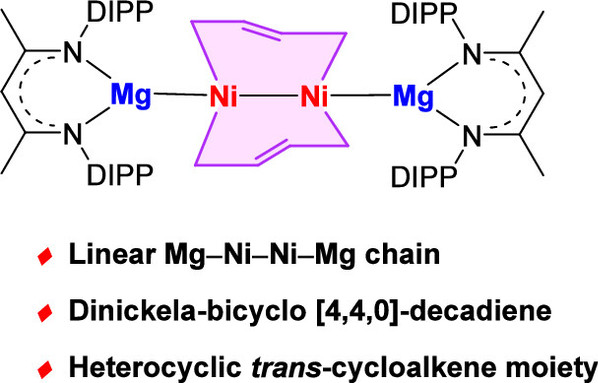Dinickela-bicyclo[4,4,0]-decadiene Complex with a Linear Heterometallic Mg-Ni-Ni-Mg Chain
Yanping Cai1, Stella Christodoulou2, Laurent Maron2*, Xin Xu1(徐信)*
1State Key Laboratory of Bioinspired Interfacial Materials Science & Key Laboratory of Organic Synthesis of Jiangsu Province, College of Chemistry, Chemical Engineering and Materials Science, Soochow University, Suzhou 215123, P. R. China
2LPCNO, CNRS & INSA, Université Paul Sabatier, 135 Avenue de Rangueil, Toulouse 31077, France
J. Am. Chem. Soc. 2025, 147, 40719–40726
Abstract: Transition metal–diene complexes constitute a fundamental class of organometallic compounds, in which conjugated dienes typically behave as neutral π-donor ligands. While doubly reduced enediyl derivatives have been occasionally documented in the literatures, dinuclear transition metal complexes featuring such bonding motifs have not been explored. Herein, we report a heterometallic complex [(LMg)2Ni2(C4H6)2] (L = [(DIPPNCMe)2CH]−, DIPP = 2,6-iPr2C6H3) featuring a linear Mg-Ni-Ni-Mg bonded chain, which was formed by the reaction of LMgBu·Et2O with Ni(cod)2 (cod: 1,5-cyclooctadiene). Experimental and computational studies reveal two s-trans-butadiene ligands bridging the Ni–Ni bond in a doubly reduced enediyl configuration. This unique bonding arrangement results in a dinickela-bicyclo[4,4,0]-decadiene framework containing a heterocyclic trans-cycloalkene moiety. Treatment of [(LMg)2Ni2(C4H6)2] with the additional butadiene afforded [(LMg)2Ni2(C4H6)3], involving three C4H6 ligands bound to nickel centers, in which they behave as two doubly reduced enediyl ligands and one neutral butadiene ligand. In contrast, upon exposure to carbon monoxide (CO), a ligand exchange reaction occurred, yielding [(LMg)2Ni2(C4H6)(CO)4] with one C4H6 ligand, which is considered as a dinickelacyclo-4-hexene supported by Mg-metalloligands.

Article information: https://doi.org/10.1021/jacs.5c13473